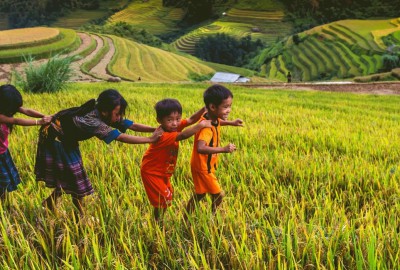Coming to Ba Be National Park, you can take a boat to discover the beauty of this place. There are big boats, small boats and dugout boats for adventure lovers. Sitting on a lonely boat between the immense river, mountains and forests, listening to the legend of the lake through the words of the boatman will surely be an interesting experience.
Trekking, boat trip, homestay is the most exiting in Ba Be National Park tours. Ba Be National Park is also the homeland of Tay Ethic minority where you can learn of their custom culture and daily life.
Here are top things to do in Ba Be National Park:
1/ LAKE KAYAKING

This is the best way to explore the breathtaking beauty of Ba Be Lake. The small boat is perfect to get up close to the karst mountains and slip into the small caves. With no engine you can get much closer to many different species of wildlife on the lake very safely. A real eco-way to travel and at your own pace!
2/ CYCLING

The roads of Ba Be are very quiet and perfect for cycling. They are in a good overall condition and the traffic is minimum. The great advantage about cycling is that you can cover more distance in one day, and stop wherever you like to appreciate the spectacular countryside and endless variety of landscape – from the rice fields to the towering mountains, steady ascents and awe-inspiring descents.
3/ TREKKING & HIKING

Considered by many as the best trekking areas in the north of Vietnam, Ba Be National Park and its beautiful landscapes is still much protected from mass tourism. The variety of the scenery is impressive from rich vegetation to sudden rice fields carpeting the mountains. This activity is also ideal to meet the locals and share experiences with them when you stop for a drink or lunch.
Local guides are a plus as they know the best routes through the park and will be able to take you to the best spots while sharing stories about the park, the ethnic minorities and its fauna.
4/ LOCAL FOOD
Because of Ba Be’s favourable farming and fishing conditions, the food in this area is varied and fresh. It is a real feast every time with locally grown vegetables to free range meat and fish from the lakes and rivers. Another accompanying dish eaten a lot in Asia, is of course rice. In the North they prepare a special recipe called com lam, otherwise known as bamboo cooked rice. The Tay people prepare it by pressing wet rice – com – with salted water and sometimes coconut water, into bamboo tubes, and cook them in banana leaves. Any amateurs?
After a delicious meal, it is time to try the local rice wine, Noc Suong. Very popular and generally homebrewed, the spirit is perfect to create bonds with people after a long day.
5/ ETHNIC MINORITIES

There are three main ethnic minorities in and around Ba Be National Park: the Tay, the Dzao and the H’mong. They form communities ranging from small clusters to larger villages with wooden stilt houses.
The Tay people are famous fishermen and woodworkers. They can often been seen travelling in their canoes named doc moc. The boats are skilfully crafted from one tree trunk, with a very narrow shape to glide easily through the water.
The H’mong community live an agricultural lifestyle, farming pumpkins, maize, soya and rice. Linen weaving is one of their most unique productions as their clothing is so rich in colours and types.
The Dzao communities cultivate swidden fields, rocky hollows, and wet-rice paddies. They preserve and develop a very rich unique culture, in which, singing and poetry composition is the most popular entertainment activities.
6/ CAVE EXPEDITIONS

Caving is an absolute must-do in Ba Be to enjoy the full experience the park offers. Below the surface lies a fascinating cave system with amazing rock formations. Puong Cave is a well-known cave with its 300 meter-long tunnel, but none is as mystical as Hua Ma Cave, whose myth kept people away for many years! Hua Ma is an 800 meter-long cave complex with a pathway leading down into a soaring cavern full of stalactites and stalagmites. The legend says that a long time ago, cries would come out of the cave and resonate in the mountains at night. The cave was said to detain the spirits of innocent people killed during the wars. So the King offered the heads of his horses to deliver them and ordered his troops to build a pagoda to pray for these souls. Not a sound was heard since then.
A guide is strongly advised to explore the caves, and appropriate equipment including practical footwear and lights, unless provided by the tour guide.
7/ FISHING
Ba Be is a prime example that harmony between man and his environment is possible. The local communities here use ancestral techniques to fish on the lake. They work from a very thin and long boat during hours to catch shrimps and catfishes.
If you enjoy fishing, this activity can allow you to get a private insight into Vietnamese rural life in Northern Vietnam, and share fishing skills with the locals.
8/ DAU DANG WATERFALL

The waterfall is located where the Nang River enters the Tuyen Quang Province. It flows for 2km where the Nang River is blocked by various sized stones and falls into a gorge between two lakes. Here the water turns from green to white as it crashes off the rocks.
This area also has magical origins as it is believed that a giant discarded the stones here after he hollowed out Puong Cave.
9/ LOCAL HOMESTAY
A local homestay is the only sensible choice if you want to complete your experience of Northern Vietnam. It is a must if you are looking for the most authentic and enriching experience possible. Staying with a local family, often several generations under the same roof, and sharing their meal and their stories, is a great way to create memories.
Moreover, it is a plus to know that the money spent for the accommodation and food stays into local hands, and benefits directly to the community.


























